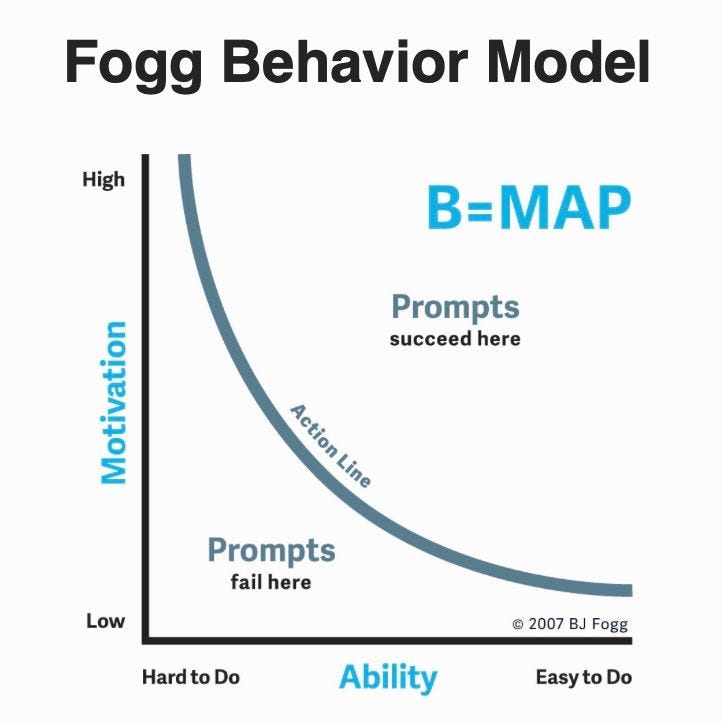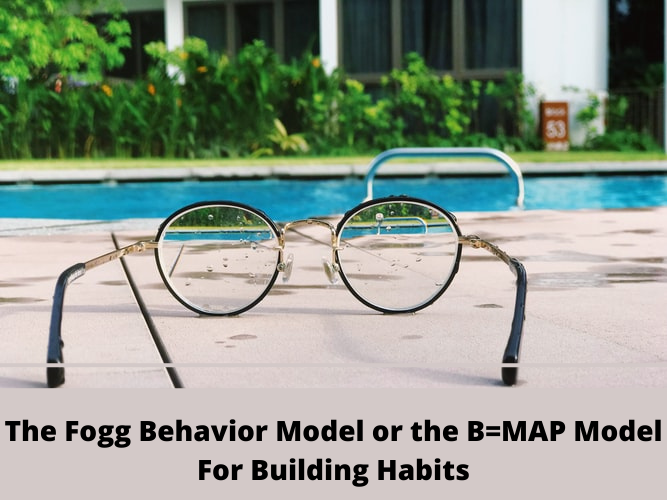Everything you need to know about the Fogg Behavior Model to welcome transformation into your life and build lasting habits.
According to BJ Fogg, the founder of the Behavior Design Lab at Stanford University, a behavior happens when motivation, ability, and a prompt converge simultaneously. This is known as the Fogg Behavior Model or B=MAP.
If you want to change your life, you’ll have to change your behaviors. There are only three simple variables that drive those behaviors. That’s where the B=MAP model comes in. It is the framework to understand and unlock the mystery of how habits take root in routines. It will help you adopt helpful habits and get rid of unhelpful ones. This post outlines the B=MAP model and lays down steps how you can apply it in your life to make room for transformative change.
The B=MAP Model
Behavior is the result of motivation, ability, and prompts taken at the same time. This is a simple formula that can lead to incredible results. In other words, a behavior is the result of:
- Motivation, or your desire to execute the behavior.
- Ability, i.e. your capacity to execute the behavior.
- Prompt, or your cue to execute the behavior.
This is true for building a habit and breaking an old habit in equal measure.
“You can disrupt a behavior you don’t want by removing the prompt. This isn’t always easy, but removing the prompt is your best first move to stop a behavior from happening.” — BJ Fogg
The following sections will discuss each element of the B=MAP in detail and ay down actionable steps you can execute right away to welcome change into your life.
Motivation
Most people wrongly assume that motivation is all you need to successfully build a new habit. Fogg disagrees, stating that motivation is only one part of the equation. And as we all know. motivation is unreliable. It doesn’t last forever.
According to Fogg, there are three sources of motivation:
- Yourself, i.e. what you know you want.
- A reward or punishment you know you would receive if you complete the behavior.
- The context, i.e. if people around you are doing it as well.
The best kinds of behaviors you can focus on are what Fogg calls “Golden Behaviors”. It has three elements, namely, it should be effective in realizing your aspiration, you should want to do the behavior, and you are fully capable of executing it.
Ability
If you’re able to execute a behavior, you’ll not need much motivation to continue doing it. When you’re struggling to build a new habit, ask yourself what Fogg calls the Discovery Question: What is making this behavior hard to do?
This is not only an incredible exercise in self-reflection, but is also a helpful step towards solving your inability to build the habit. As Fogg’s research suggests, your answer to the Discovery Question could be a combination of the following (Fogg calls them Ability Factors):
- Do you have enough time to do the behavior?
- Do you have enough money to do the behavior?
- Are you physically capable of doing the behavior?
- Does the behavior require a lot of creative or mental energy?
- Does the behavior fit into your current routine, or does it require you to make adjustments?
Another question you Fogg suggests you ask yourself is the Breakthrough Question: How can I make this behavior easier to do? There are only three answers to this, according to Fogg’s research:
- Increase your skills. Research more on the habit you’re focussing. You should do this immediately when your motivation is high. This can be done by reading books, watching tutorial videos, or joining a group of likeminded people.
- Get tools and resources that help you with the new habit.
- Make the behavior tiny. Focus on the starter steps — one small habit you can do every day that will lead you towards your desired behavior. In case you are trying ot break a habit, you should taking the behavior you want and shrink it, one step at a time.
Prompts
Prompts are the triggers or cues that push you to start the habit. As per Fogg’s research, there are three types of prompts:
- Person Prompts: When you rely on a prompt from within to start a behavior, for example, a sore back might prompt you to stand up and stretch. While useful, such prompts are unlikely to lead to lasting change as they are so unreliable.
- Context Prompts: These are cues in your environment that urge you to take action, for example, an alarm clock or a notification on your phone. They are useful, but having too many to manage can lead to overwhelm.
- Action Prompts: These are the most reliable type of prompts, and as Fogg defines, “a behavior you already do that can remind you to do a new habit you want to cultivate.” For example, an existing habit of making coffee for yourself ever morning can serve as a prompt to take your medications.
“Action Prompts are already embedded in your life so seamlessly and naturally that you don’t have to think about them.” — BJ Fogg
How to apply the B=MAP model
Fogg proposes a simple graph to help us understand how to build a new habit or behavior. Along the vertical axis is Motivation (M) which varies between High and Low. Along the horizontal axis is Ability (A) which varies between Hard to do and Easy to do. Then, the Prompt (P) lands either above or below a curved line on the graph, known as the “Action Line.”
The position of your Prompt in relation to the Action Line determines whether you’ll do a Behavior (B) or not.

In Fogg’s own words: “When a behavior is prompted above the Action Line, it happens. Suppose you have high motivation but no ability (you weigh 120 pounds, but you want to bench-press 500 pounds). You’re going to fall below the Action Line and feel frustrated when you are prompted. On the other hand, if you are capable of the behavior but have zero motivation, a prompt won’t get you to do the behavior; it will only be an annoyance. What causes the behavior to be above or below the line is a combination of motivation pushing up and the ability to move you to the right. Here’s a key insight: Behaviors that ultimately become habits will reliably fall above the Action Line.”
